Athens, Delphi and Peloponnesos
The gods from the myths are still around
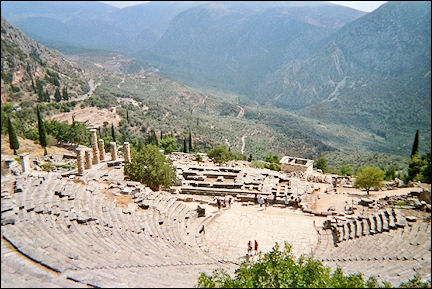
|
A visit to Athens with its Acropolis, a trip to the Delphi Oracle and then via Corinth to Paralio Astros, to explore part of the Peloponnesos: the Cyclops fortress of Mycenae, the theatre and Asclepion in Epidaurus, the port town Nafplio and the car-free Saronian island Hydra and last but not least the temple of Apollo Epikourios at Bassae.
Travelogue & photos: Luk Carion
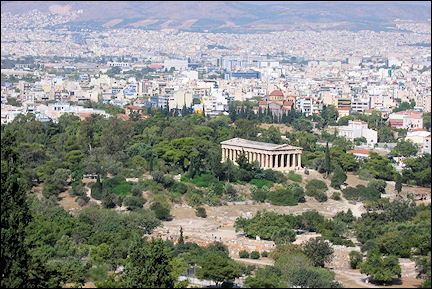
|
Half way to the top of the Acropolis ("high city"), situated on a plateau at 156 meters, I catch my breath on a terrace. Above me, thousands of years old historical landmarks, beneath me the Agora (marketplace), dominated by the Hephaestus temple in the distance.
Hephaestus is the god of forgery, fire and volcanoes; he is the gods' smith. His temple is a 5th century landmark. Farther away, I see modern Athens, a huge metropolis. From this altitude, it looks immeasurable.
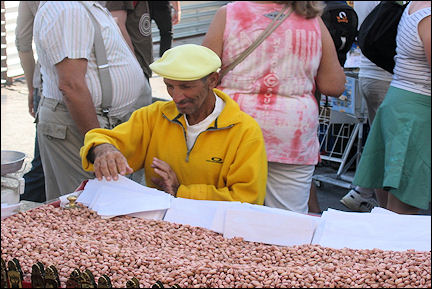
|
On arrival at the Athens airport we'd already noticed the huge tarmac and the crowds. The city doesn't stay behind: Athens is busy, very busy.
Enormous amounts of mopeds (no scooters here like in Rome) race by, stinking and noisy. Cars are constantly honking. This is Paris and London squared.
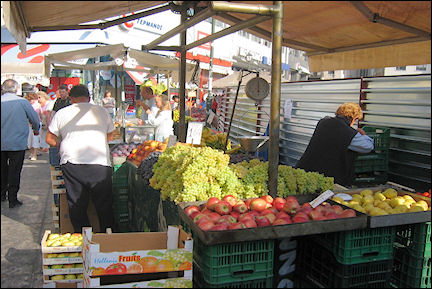
|
On squares are stalls with vegetables and flowers. Fortunately, Athens has a subway, which works perfectly and makes you forget the pain of all that noise for a while. But it's best to visit a city on foot. And in Athens that doesn't only make your feet hurt, but also your ears.
But it has to be said: they are friendly, those Athenians. Even cordial.
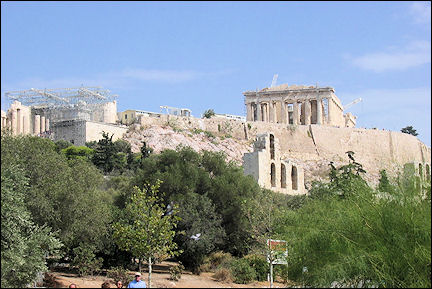
|
The heat of the sun, the view of the Agora and nearby hills: I could sit here for a long time. But I have to get up the holy mountain. Holy because of the temples; in Mycenaean times, the Acropolis was only a fortress.
The path is steep. The Dionysus theatre, the cradle of drama, lies at my feet. Here the masterpieces by Euripides, Aeschylus and Sophocles were performed. The audience didn't only have a great view of the stage, but also of the slopes and woods in the distance. With a little imagination, one can see the theatre full of spectators, the actors with their masks, hear the cheers of the audience, the joy and the painful sadness of the play.
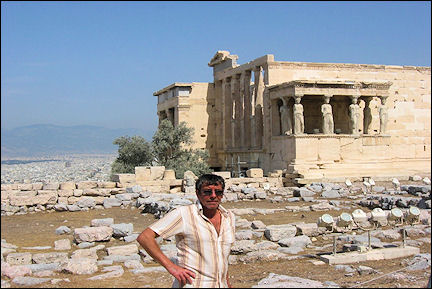
|
A little higher and I am facing the Acropolis: currently under repairs and - probably as always - swamped with tourists. It's a must-see while being in Athens.
The Parthenon, a temple dedicated to the goddess Pallas Athena, is the most impressive: austere, but architecturally innovative (some tricks were applied to make the Dorian construction look elegant).
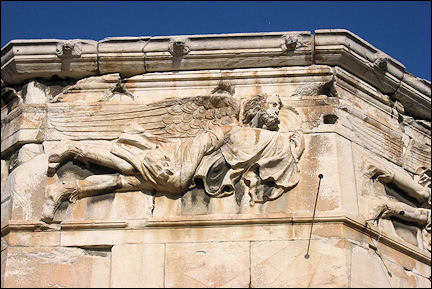
|
I walk back down to the city. Along the Roman Agora, with its 12 m high Tower of the Winds, an octogonal water clock with sun dial, compass and wind vane. The city's noisy hustle and bustle gets nearer. Time to take a break and digest the first impressions.
In the evening we walk to Plaka, in the past Athens' working class district, now a tourist town with many shops and restaurants. But it's lively and less noisy than in the rest of the city.
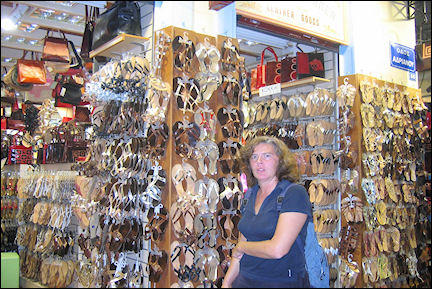
|
From there I see the Acropolis on the hill, enchantingly illuminated. It makes me feel humble to see those over 2000 years old landmarks. I take solace in the thought that in those times there probably was something like Plaka as well.
Delphi
The oracle was high on volcanic vapors
The drive to Delphi is uneventful and leads along small villages and through panoramic landscapes. Here in Delphi was - according to the ancient Greeks - the center of the world, in a passionately wild landscape between mountains. For hundreds of generations prayers were offered, sacrifices to the gods were made and prognostications were uttered by the oracle.
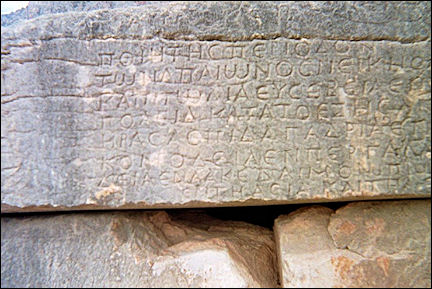
|
Deep below us lies the valley of Pleistos, the Sacred Plain, and above us hover the two peaks of Parnassos. In this immense nature one feels small, insignificant and powerless as a human being. One talks quietly, there aren't that many tourists, and the ones that are, are quiet and modest.
I get on the "Sacred Road" on which in antiquity thousands of pilgrims walked every year. The road leads to the temple of Apollo, where the Delphi oracle was. The suns shines bright. Along the road I see inscriptions on the walls: they are all names of slaves who were set free here after hard labor on this mountain slope.
The earliest traces of religious activity on this site date from the Mycenaean period. From the 7th century BC, the oracle experienced a Golden Age, which lasted, with interruptions, until 390, when the Roman emperor Theodosius I, a fanatical Christian who wanted to obliterate all pre-Christian religious practices, closed it permanently.
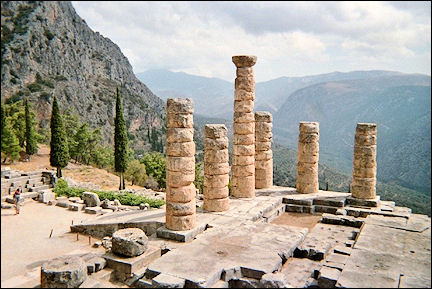
|
After a few minutes I arrive at the Apollo temple in its last version, which dates from the 6th century BC. Unfortunately, it can't be visited, ropes around it close it off from visitors. Inside used to be the omphalos or navel stone, which indicated the center of the world.
The omphalos covered a crack in the earth, from which volcanic fumes rose.
Here, the Pythia, a seer, received her oracle prophesies. At first, the seers were young virgins, but after a scandal they were replaced with riper women. The Pythia sat in a chair over the omphalos. Chewing bay leaves and inhaling the fumes from the earth (possibly ethylene), she got intoxicated. Once she was in a trance, the Pythia uttered incoherent sounds, which were assumed to be messages from the gods. Priests translated those messages, but they always remained ambiguous.
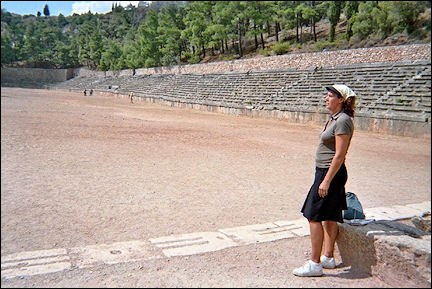
|
I climb higher up on the mountain slope and am rewarded with a great view of the well-preserved theatre. During the summer months, all arts that were associated with Apollo (playing the flute, singing, reciting Homer and plays) were performed here.
The road leads farther up along a fir forest. After a quarter of an hour climbing, I see the well-preserved stadium, high on the slopes of the Phedriads, which was the arena for the athletic competition during the Pythian games.
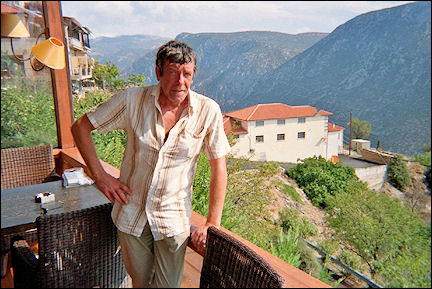
|
What strikes me most are the starting blocks, or rather, that they are still there. The view of the surrounding mountains here is superb. Descending again, we are surprised by beautiful bird's-eye views of the sanctuary.
Time for a short visit to the museum, where the bronze statue of the charioteer draws most attention. We continue to the village of Delphi for a drink: it's a small, simple but very touristic village. We pick a terrace with a view of the valley and see the sea in the distance. The sun shines, it's pleasant here with this view and also with the beautiful memories of the sanctuary.
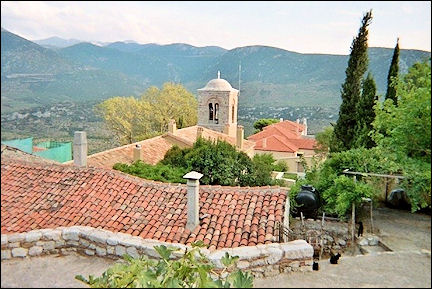
|
We take the highway back to Athens. It would be a shame to miss the Byzantine monastery Ossios Loukas, which is located in gorgeous surroundings. I admire the wonderful Byzantine architecture; a monk greets me friendly.
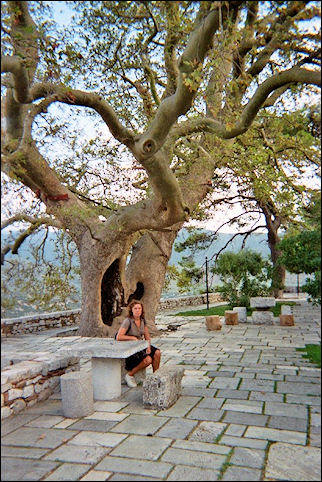
|
Since old times monks had a gift for finding the most beautiful spots: good for meditating in any case. Along the esplanade, lined with centuries-old trees, are benches. I sit down and enjoy the breathtakingly beautiful nature around me.
A little later I walk to the St. Lucas church, built in 11th century, in the shape of a Greek cross. In the church's portal, the Byzantine mosaics define the atmosphere. We decide to light a candle, in this place of meditation and contemplation, far away from the hellish pace of life.
We end our visit walking to an old chapel with a water well. Delphi and Ossios Loukas: these sanctuaries are very old evidence that questions about life and mysteries have always existed and are probably universal.
Peloponnesos
Thousands of priestesses were sacred prostitutes
We leave Athens and drive to the Peloponnesos. We sit in a traffic jam for over two hours before we reach the highway to Corinth. An excellent highway, but monotonous and boring. Here and there we see remains of the wildfires that raged her (only a foretaste of what we'll see later).
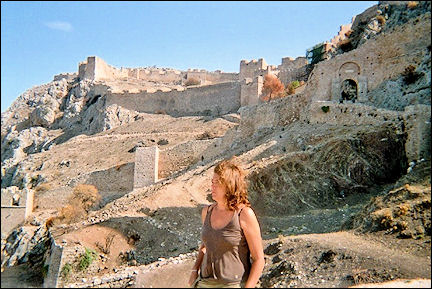
|
We don't like Corinth's Agora. With the exception of the Apollo temple, one has to be an archeologist to find one's way between the fragments (the place has been devastated by earthquakes more than once). On a high hill, 575 meters above Corinth, one can see Akrokorinthos, the city's old acropolis, which looks like an eagle's nest.
A Byzantine fortress, half-hidden between herbs and poppies, reinforced walls and especially the three impressive entrance gates (built by the Ottomans, French crusaders and Venetians), impressive defensive walls, a chapel...
Originally - and I find some remains - there was a temple here devoted to Aphrodite: thousands of priestesses, accompanied by dancers, practiced sacred prostitution here. I allow my imagination to drift... A nice breeze brings me back to the here and now: the view of the Bay of Corinth. Not a tourist in sight and still this place is more than worth a visit.
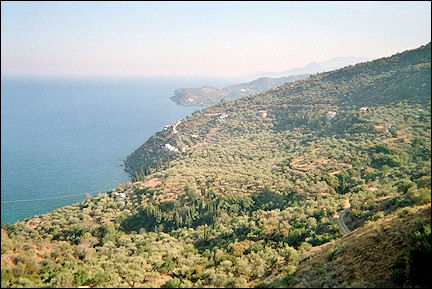
|
It's already afternoon and we still have to find a place to stay for the coming week. We take the road to Leonido, southward; it's a wonderful coastal road in an authentic and wild landscape with lookouts to admire the views of the many bays.
We stop in Paralio Astros, a quiet, traditional fishers village on the Gulf of Argolís, where many Athenians have a second home. We drive along the shore and pass some bars and restaurants. Suddenly a man approaches us, gesticulating wildly: he apparently understands that we are looking for accomodation. Sign language helps.
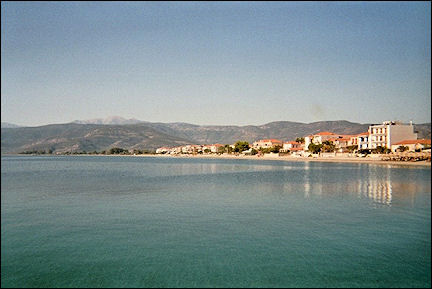
|
He gets in his car and leads the way to a building just outside the center and shows us a beautifully furnished apartment with two terraces (one with a sea view, the other with a view of the mountains). 200 euros for a week sounds like and excellent deal. We take a walk along the sea, visit the port and have a tasty snack. This will be our operating base for the next couple of days.
Mycenae
In the Cyclops fortress bloody conspiracies were hatched
Today we go over 3200 years back in history. The heyday of Mycenae lasted from 1400-1200 BC. We again take the coastal road, this time to the north, to Mycenae, the city that Homer endowed with the epiteth "gold-rich Mycenae" and a city of much bloodshed.
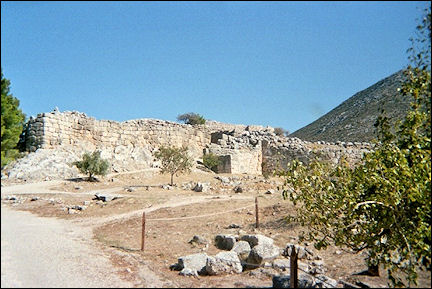
|
The road to Mycenae winds along vineyards, olive groves and orange trees. The battle of Troy (around 1180 BC) was prepared here, under commander in chief Agamemnon, King of Mycenae.
Mycenae's acropolis is surrounded by 6 meters thick, cyclopic walls, which originally were ten meters high. Within the walls only the nobility lived, the common people lived scattered outside the fortress. In this fortress conspiracies were hatched, revenge was taken, hate harboured. Agamemnon was assasinated in his bath, after he returnd from Troy victoriously, by his wife Klytemnestra.
I enter the fortress through the Lions Gate (actually: Lionesses Gate). The relief over the gate is Europe's oldest monumental sculpture. The treshold stone has deep carvings, undoubtedly left by Mycenaean chariots. I continue on the King's road, extremely slippery because of the millions of feet that polished it over time. On this road Homer's heroes walked (in ancient times...), rulers of mighty empires and their wives and mistresses.
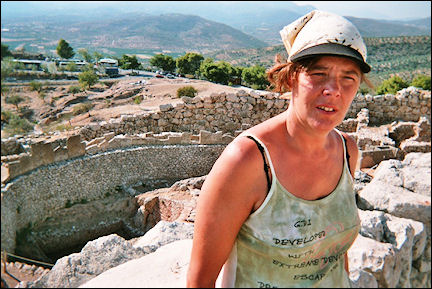
|
This place evokes melancholy: there are still traces of the past, but one is confronted with the fleeting nature of existence, even of great empires. The first reminder of this is seen immediately past the Lions Gate to the right: a round tomb.
I ascend the King's road further toward the palace. On the highest point of the acropolis I sit down for a while. The vast landscape is extraordinarily beautiful. This is a place to sit for hours and dream about the past.
A little farther is the Treasury of Atreus (Agamemnon's father), a huge domed tomb.
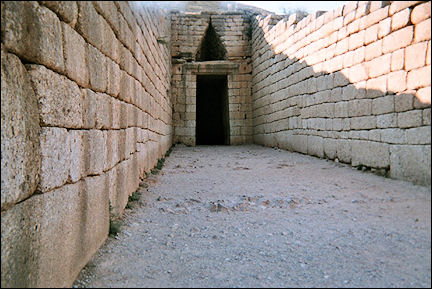
|
There must have been immense logistic and organisational problems in the construction of this 13 meters high structure. How, for example, did the Mycenaeans place the 120 tons weighing covering stone on the tomb?
The tomb consists of perfect circles of stones in 33 layers, narrowing towards the covering stone. The acoustics are ghostly. The large amount of jewelry which was found here and on the acropolis, is exhibited in a separate room of the Archeological Museum in Athens.
Epidaurus
Spiritual balane was considered more important than health
The road to Epidaurus leads along vast orange and olive groves. Epidaurus is mostly known for its 4th century BC theatre, which was uncovered only in the 19th century: it was covered by mud for ages. The acoustics are phenomenal, thanks to its perfect measures: the proportion between height and diameter was crucial in this.
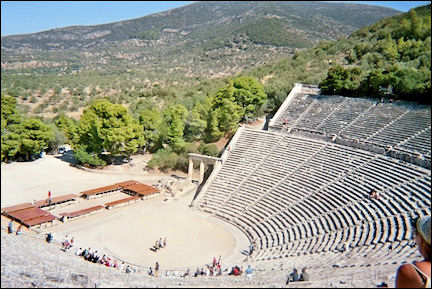
|
The theater is like a huge shell, impressive and amazing, especially standing at its lowest point, were the actors stood. To get there, I follow a path lined with fir trees with singing cicadas. The scent of the surrounding mountain air is intoxicating.
I climb 55 rows up: from here the theatre with its 14,000 seats seems part of the indescribably beautiful landscape.
Near the theatre of Epidaurus is the Asclepion (Temple of Sleep), an ancient Greek sanatorium with one of the first hospitals of antiquity. It's uncertain if Asklepios, son of Apollo and half god of medicine, actually worked in this sanctuary.
The treatment consisted of a cleansing ritual (bathing), followed by inhaling incense and other fumes to induce a deep sleep. Asklepios' servants mumbled hypnotizing prayers. Sleep was essential, because in it, Asklepios would give clues about the appropriate therapy. When one saw a snake in one's dreams, one was cured. The staff of Asclepios, esculape, still is a symbol for doctors and pharmacies.
Therapy was based on a diet, relaxation and physical exercise, bathing and intellectual entertainment. Which explains the theater. Not the recovered health was essential, but the found spiritual balance, a better relationship with the forces of life, nature, the gods, the cosmos.
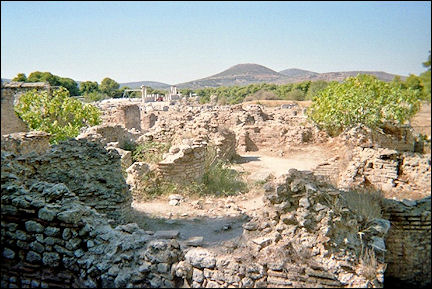
|
Remaining inscriptions prove that the Asclepios priests were averse to scientific medicine, which was taught by the School of Hippocrates of Kos (460-370 BC).
I take a walk in the Asclepion, see the hospital which clearly has two wards, one for contagious diseases and one for others. In the back is a stadium.
It's the same triptych as in Delphi: sport to reinforce the body, theatre to relax and entertain the mind and magic (in Delphe the oracle, here dream therapy to get access to the divine). This is no coincidence, in both places medicine still was at the stage of magic, sorcery and religion.
Reluctantly, because I would have loved to stay longer, I leave this place after a visit to the museum, which has a collection of medical instruments and notes from cured patients.
Nafplio and Hydra
Turkish fountains and Venetian houses
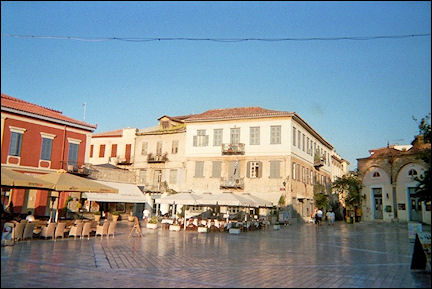
|
Nafplio, a pretty Greek port town between Epidaurus and Paralio Astros on the Gulf of Argolís, originally was the capital of what now is Greece.
Nowadays it's an important commercial center, among other things for produce from the region: the Peloponnesos is Greece's kitchen garden. Most streets around the central square are narrow and connected by stairs.
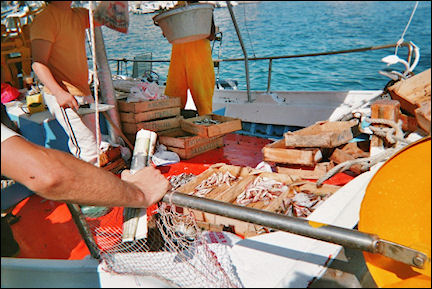
|
Several Turkish fountains remind of the Turkish occupation of Nafplio. Since the Venetian era, the Platía Syntágmatos is the center of public life. This nicely paved square offers visitors a pleasant visit to the many bars and restaurants.
It looks exactly like it did in the 18th century, when the Turks built several mosques here. Beautiful houses surround the square.
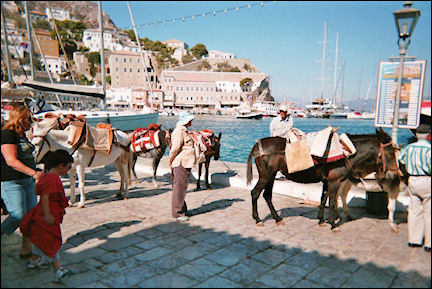
|
From here it's only a short drive southward to Tolo, a touristic beach resort, where a boat takes us for a one-day visit to Hydra, an island with one of the most beautiful ports of Greece. And there are no cars or motor bikes here!
The island looks pretty in the bright September sun. In the past, it was a pirates nest. I wander around, in the afternoon we have (again) a Greek salad with many fresh and juicy tomatoes. On the way back, I muse about Greece, history, my self and tomorrow...
Bassae
The Apollo temple sits in a unique Arcadian landscape
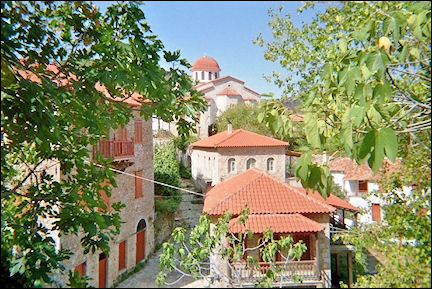
|
Today is filled with expectation: deeper into the Peloponnesos, the inland, and on my way to what I loved most there decades ago: the temple of Apollo Epikourios (5th century BC) near Bassae.
We travel slowly through a wild Arcadian landscape, it's all so beautiful. The village of Andritsena lies charmingly scattered over the green mountain slopes, half hidden between trees on the banks of some meandering rivers. The slender cypresses push their crowns high up between the plane trees. Olive trees stand in gardens with gurgling wells, where the red roofs of the houses shine between the greenery.
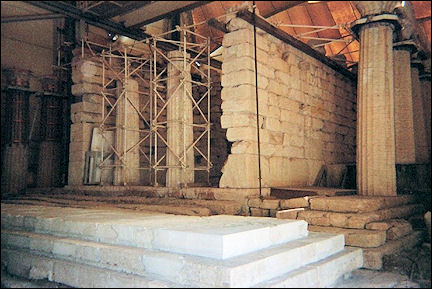
|
On the central square in Andritsena, the inhabitants sit outside, sipping ouzo. I want to get old here. In a house in one of those narrow alleys. Unfortunately, the surroundings are scorched: the wildfires here were devastating.
Near by is the Apollo temple of Bassae, the best-preserved and most beautiful of Greece, at an altitude of 1150 m. All by itself, without any human presence, in a unique landscape. Unfortunately it's covered in a huge canvas, to protect the Dorian columns from frost damage while repairs are being made.